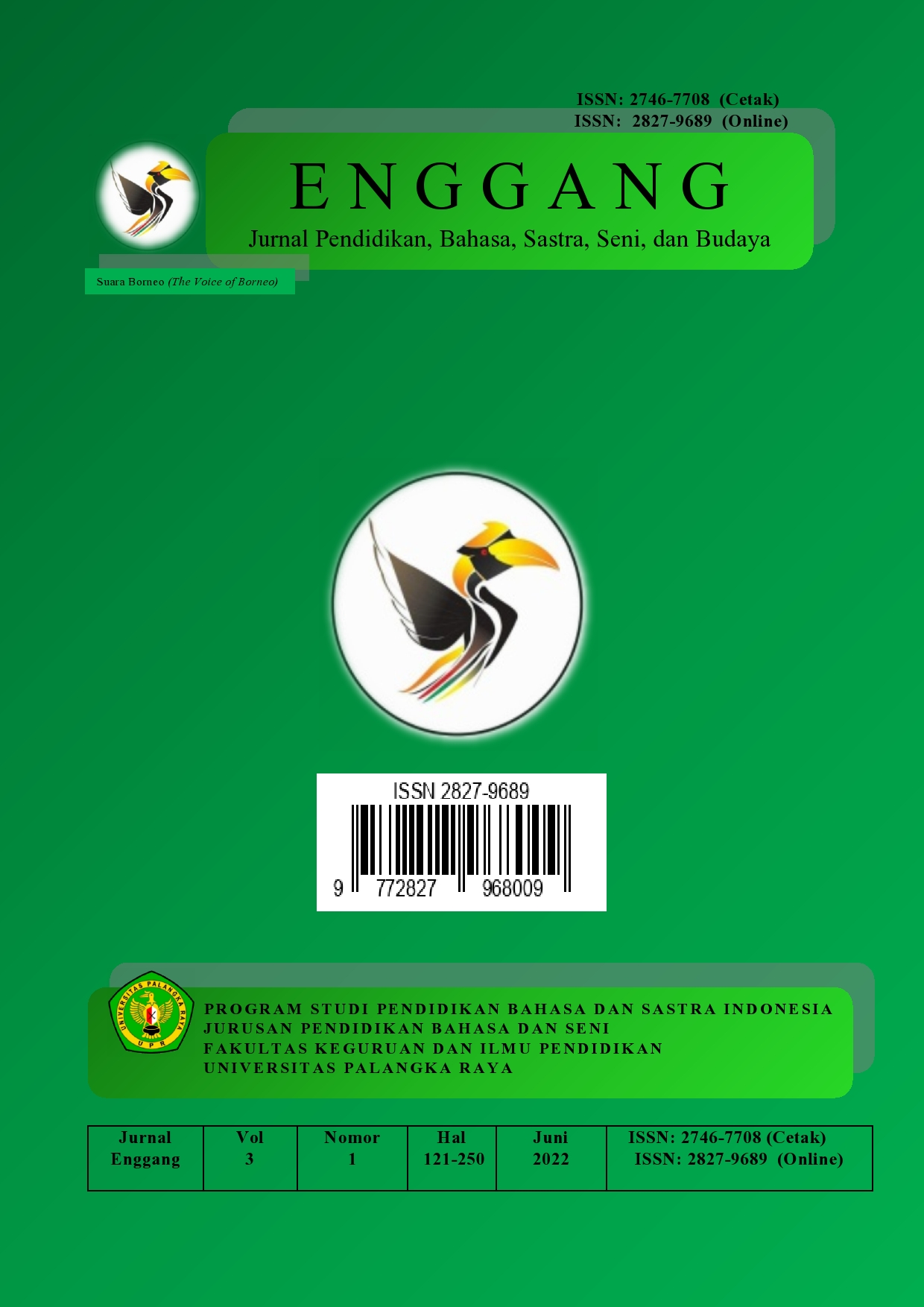RELASI SINTAGMATIK MITOS DAN RITUAL DAYAK MAANYAN PAJU SEPULUH SYNTAGMATIC RELATIONS OF MYTHS AND RITUAL OF THE DAYAK MAANYAN PAJU SEPULUH
DOI:
https://doi.org/10.37304/enggang.v3i2.12197Keywords:
relationship, myth, ritual, MaanyanAbstract
Myth and ritual are understood as two things that cannot be separated from one another. The relationship between the two can be transformed in the form of positional relations which show a network of relations between figures and events, domains and characters in a model. Given the importance of myths and rituals in forming the structure of the mind of the Ma'anyan Dayak tribe, it is interesting to present an analysis with regard to syntagmatic and paradigmatic relations in the Ma'anyan Dayak traditional marriage ceremony. The purpose of this study was to gain knowledge about myths, the meaning of myths, and their relation to rituals performed by the Maanyan Paju Ten Dayak community. The data collection technique was carried out by hermeneutic reading. Data analysis was carried out by structural analysis, semiotic analysis and content analysis guided by the Levi-Struss structural approach strategy. The results of the analysis of syntagmatic and paradigmatic relations show that myth in naliwakas is a Ma'anyan human dialectic with social reality that contains the framework of a religious system which in the past or present has been or is being applied as religious truth. The rituals that are performed basically represent the arrangement of symbols that are objectified in myths. On the other hand, ceremonies in the Maanyan Dayak community are associated with magical acts and the cult of the ancestors as religious acts. Rituals that reveal historical and social relations by referring to mystical notions within the framework of constitutive rituals, in this way the traditional wedding ceremony becomes distinctive. Furthermore, the meaning associated with this relationship is nothing but purification and protection which is called factive ritual.
Downloads
References
Ahimsa-Putra, Heddy Shri.2001. Strukturalisme Levi-Struss: Mitos dan Karya Sastra. Yogyakarta: Galang Press.
----------- . 2001. Dari Antropologi Budaya Ke sastra dan Sebaliknya. Yogjakarta: Pen Qalam.
Cobley, Paul dan Litza Jansz. 2002. Mengenal Semiotika for Beginners, terjemahan dari Semioties for Beginners, 1997. Bandung: Mizan.
Diman, P. (2020). Nyanyian Adat Masyarakat Dayak Maanyan: Suatu Pendekatan Hermeneutika. Enggang: Jurnal Pendidikan, Bahasa, Sastra, Seni, dan Budaya, 1(1), 40-56.
Danandjaya, James. 1997. Folklore Indonesia. Jakarta: PT Pustaka Utama Grafiti.
Endraswara, Suwandi. 2003. Mistik Kejawen: Sinkretisme, Simbolisme, dan Sufisme
dalam Budaya Spiritual Jawa. Yogjakarta: Narasi
Radam, Noerid Haloei. 2011. Regili Orang Bukit. Yogjakarta: Yayasan semesta.
Rafiek, M. 2010. Teori Sastra: Kajian Teori dan Praktik. Malang: RefikA Aditama.
Geertz, Clifford. 1988. Works and Lives: The Anthropologist as Author. California: Stanford University Press.
Jassin, H.B. 1983. Sastra Indonesia sebagai Warga Sastra Dunia. Jakarta: Gramedia.
Junus, Umar. 1981. Mitos dan Komunikasi. Jakarta: Sinar Harapan.
Kadarisman, A. Effendi. 2001. Berkenalan dengan Etnopuitika. Makalah Seminar Nasional Asosiasi Tradisi Lisan Bogor.kit.
Mardiana, D., & Fauzi, I. (2022, May). Makna Kultural Benda-benda Bersejarah Peninggalan Kesultanan Kutaringin: Sebuah Pendekatan Semantik Pedagogis. In PROSIDING SEMINAR NASIONAL PENDIDIKAN, BAHASA, SASTRA, SENI, DAN BUDAYA (Vol. 1, No. 1, pp. 247-262).
Misnawati, M. (2023). Melintasi Batas-Batas Bahasa Melalui Diplomasi Sastra Dan Budaya: Crossing Language Boundaries Through Literary And Cultural Diplomacy. Pedagogik: Jurnal Pendidikan, 18(2), 185-193.
Misnawati, M. (2022). Teori Ekopuitika untuk Penelitian Sastra Lisan. Drestanta Pelita Indonesia Press.
Misnawati, M., Poerwadi, P., Nurachmana, A., Veniaty, S., Lestariningtyas, S. R., Christy, N. A., ... & Rahmawati, S. (2022). The Ekopuitika Theory. International Journal of Education and Literature, 1(1), 54-62.
Misnawati, M., Maysani, D., Diman, P., & Perdana, I. (2022). Keindahan Bunyi Sebagai Identitas Kultural Masyarakat Dayak Maanyan Dalam Sastra Lisan Tumet Leut. Drestanta Pelita Indonesia Press.
Misnawati, M., Poerwadi, P., Anwarsani, A., Nurachmana, A., & Diplan, D. (2021). Representation of cultural identity of the Dayak Ngaju community (structural dynamic study). JPPI (Jurnal Penelitian Pendidikan Indonesia), 7(4), 690-698.
Poerwadi, P., & Misnawati, M. P. Deder dan Identitas Kultural Masyarakat Dayak Ngaju. GUEPEDIA.
Poerwadi, P., Misnawati, M., & Sari, F. M. (2023). Literary Phenomenology in Ngaju Dayak Folklore. Journal of World Science, 2(2), 261-277.
Setiawati, R., Misnawati, M., Linarto, L., Purwaka, A., & Prihatini, I. (2023). Nilai Sosial Dalam Pernikahan Adat Suku Dayak Ot Danum di Kabupaten Seruyan. Bhinneka: Jurnal Bintang Pendidikan dan Bahasa, 1(4), 235-248.
Susanto, P.S. Hary. 1987. Mitos Menurut Pemikiran Mircea Eliade. Yogjakarta: Kanisius.
Teeuw, A. 1983. Membaca dan Menilai Sastra. Jakarta: Gramedia.
Ukur, F. 1971. Tantang Jawab Suku Dayak. Jakarta: BPK Gunung Mulia.
Vansina, Jan. 2014. Tradisi Lisan sebagai Sejarah. Yogjakarta: Penerbit Ombak.
Widen, Kumpiady. 2011. Dayak Maanyan: Sejarah dan Perkembangannya. Jakarta: Midada Rahma Press.
Widia, E., Poerwadi, P., Misnawati, M., Cuesdeyeni, P., & Linarto, L. (2023). Makna Simbolik Natas Banyang Pada Upacara Pernikahan Adat Dayak Maanyan di Barito Timur Dan Implikasinya Terhadap Pembelajaran Sastra di SMA. Bhinneka: Jurnal Bintang Pendidikan dan Bahasa, 1(4), 155-171.













